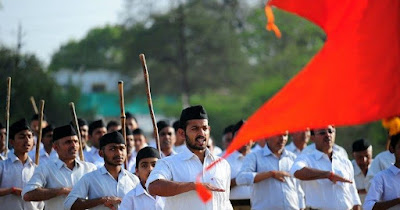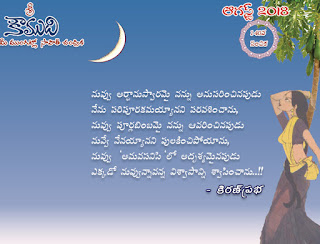Independent India has developed a strong appetite
for aspects of fascism, including Nazi ideology.
Sanjay Kanojia / AFP
Two years ago, I awoke to the
following tweet, “I hope another Hitler comes back and finishes off your
people”, accompanied by a picture from 1945 of the bodies of dead Jews piled
outside a liberated concentration camp. Since then, I have been regularly
attacked with anti-Semitic language and tropes on social media, especially on
Twitter.
I am a target for anti-Semitic
insults due to my work: I am a historian of premodern India. My research
primarily concerns the Mughals, a Muslim dynasty that ruled much of north and
central South Asia in the 16th and 17th centuries and built the Taj Mahal. Most
historians – especially those who work on non-Western, premodern topics – find
their audience confined to scholars and students. But Indians have a voracious
appetite for history, and the historical legacy of Islam in India has become a
subject of explosive controversy in recent years. This potent combination has
made my scholarship of wide interest among Indian and Indian American readers
and has also made me a target
of vicious personal attacks on the basis of my perceived race, gender, and
religion.
Historically, anti-Semitism was not
an Indian problem. Small Jewish communities, often traders, have dotted India’s
western coast for more than a millennium. Premodern Indian Jews did not suffer
from the persecution and discrimination that often characterised the lives of
their European counterparts. In the 20th century, many Indian institutions and
independence leaders condemned rising anti-Semitism in Europe. For example,
following Kristallnacht in 1938, the Indian National Congress issued
a declaration against Hitler’s Germany. Mahatma Gandhi and Jawaharlal Nehru,
two of India’s most famous Independence leaders, condemned the Nazi treatment
of Jews.
India’s distaste for anti-Semitism
began to erode in the early 20th century, however, especially among Hindu
nationalists. Hindu nationalists – who believe that India ought to be a Hindu
nation in population and character – warmly embraced fascist ideas. The
Rashtriya Swayamsevak Sangh, a paramilitary Hindu nationalist group founded in
1925, modelled itself on contemporary European fascist movements. The Hindu
Mahasabha, a Hindu nationalist organisation founded in 1915, openly supported
Nazism, including “Germany’s crusade against the enemies of Aryan culture”, as
a spokesman for the group put it in 1939.
Rise of anti-Semitism in India
A key appeal of Nazism for early
Hindu nationalists was anti-Semitism, which they saw as a useful model for how
to demonise India’s Muslim minority. Muslims constituted 24% of the Indian
population in 1941, and they comprise 14% of Indians today (the drop is explained
by the Partition of Pakistan and its large Muslim population from India in
1947). Speaking in 1939 in Calcutta, VD Savarkar, the ideological godfather of
Hindu nationalism, identified Indian Muslims as a potential traitorous people
not to be trusted, “like the Jews in Germany”. In the same year, MS Golwalkar,
a Rashtriya Swayamsevak Sangh leader, wrote that Germany’s “purging the country
of the semitic Race – the Jews” was “a good lesson for us in Hindustan to learn
and profit by”.
For decades, Hindu nationalists
constituted a set of fringe organisations whose extreme ideas were rejected by
the wider Indian public. In 1948, a Rashtriya Swayamsevak Sangh man, Nathuram
Godse, assassinated Mahatma Gandhi, which sparked a brief ban on the group’s
operations. The Sangh experienced a remarkable recovery in subsequent decades,
however, transforming itself from an extremist association known for producing
Gandhi’s killer into the leaders of independent India. Today, Narendra Modi,
who has had a lifelong association with the RSS, leads India as its prime
minister.
Independent India has developed a
strong appetite for aspects of fascism, including Nazi ideology. Hitler’s
autobiography, Mein Kampf, has gone through countless editions in
India and has been a bestseller in the country for decades. The work is
especially popular among businessmen who see it as a self-help guide for how
determination and strength can produce success. Indeed, I was once told by a
gentleman in Bikaner, “Madam, you are a great leader like Hitler.” This was
meant as a compliment.
Growing hate and intolerance
The Indian fascination with Hitler
is often explained away as having nothing to do with anti-Semitism. Some argue
that Indians hardly learn about the Holocaust in school and that they are
historically and emotionally distant from the darker sides of Nazism. Others
point out that the Indian state enjoys robust relations with Israel.
In India, however, growing bigotry
and close relations with Israel are hardly mutually exclusive. A prejudiced
attitude against Muslims has served as a binding glue between Israel and India
over the past decade or two. Hate crimes against numerous groups – including
Muslims, Christians, Dalits, and anybody who eats beef – are on the rise in Modi’s
India. Such trends are unsurprising given the Hindu nationalist propaganda
espoused by Modi and his political party, the Bharatiya Janata Party.
Anti-Semitic attitudes are not a
central storyline in this larger flowering of prejudice, but they are a readymade
playbook of virulent hate that can be unleashed against foreign scholars.
Academics, such as myself, often contradict Hindu nationalist claims about a
pristine Hindu past, in which Muslims are seen as barbarous invaders, by
arguing that many Muslims were embedded into the fabric of premodern Indian
society. By virtue of our dedication to accuracy, scholars also shed
unfavourable light on the origins of groups such as the Rashtriya Swayamsevak
Sangh. Hindu nationalists lack the historical evidence to counter academic
claims on scholarly grounds, and so they turn to one of their most finely-tuned
weapons: identity-based attacks.
I have personally received dozens
of anti-Semitic messages over the last few years from Hindu nationalists and those
sympathetic to their cause. These ugly attacks use vicious anti-Semitic slurs,
frequently invoke the Holocaust, and draw on crude anti-Semitic tropes such as
that I am somehow pursuing my academic research for the money. Such language
feeds on a wider global rise in anti-Semitism, including violent attacks on
Jewish individuals and communities.
One curious aspect of this
anti-Semitism directed at me is that I am not, in fact, Jewish. Perhaps my last
name suggests a Jewish identity to those unfamiliar with eastern European
surnames, but I suspect that darker reasons often lurk behind this mistaken
identification. Several of my academic advisors are Jewish and frequently
maligned as such by Hindu nationalists. As a result, I am evidently perceived
as a Jew by association. More insidiously, the old anti-Semitic trope that Jews
control universities still surfaces with alarming regularity. This is a
sub-type of the foundational anti-Semitic trope that there is an international
Jewish conspiracy to run the world. In other words, anti-Semitism blinds people
into assuming that I am Jewish, and then provides them with a remarkably
hateful set of tools with which to attack me.
India has a growing problem with
hate and intolerance. Alarmingly, in recent years, much of this hate has been
sponsored by groups and figures that are close to the Indian government. Within
India, Muslims remain the chief targets of mounting bigotry and violent
assaults. When attacking non-Indians, however, Hindu nationalists increasingly resort
to the virulent anti-Semitic ideas that inspired their early leaders.
Audrey Truschke is Assistant
Professor of South Asian History at Rutgers University in Newark, New Jersey.
She is the author of two books, Culture of Encounters: Sanskrit at the
Mughal Court (Columbia University Press, 2016) and Aurangzeb: The Life
and Legacy of India’s Most Controversial King (Stanford University Press,
2017). The latter is published in India and Pakistan as Aurangzeb: The Man
and The Myth (Penguin).
Support
our journalism by subscribing to Scroll+ here.
We welcome your comments at letters@scroll.in.
Source: scrollin









